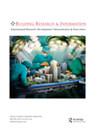澳大利亚AEC行业的循环经济:障碍和推动因素的调查
IF 3.7
3区 工程技术
Q1 CONSTRUCTION & BUILDING TECHNOLOGY
引用次数: 17
摘要
建筑、工程和施工(AEC)行业在全球范围内以资源效率低而闻名。政策制定者正在探索各种途径来解决这个问题,其中一个选择是向循环经济(CE)转变。然而,首先必须确定相关的利益相关者如何看待这个概念。因此,本研究旨在引出利益相关者对CE的看法,并确定影响其在澳大利亚采用的主要障碍和推动因素。共有132名代表不同利益相关者团体的受访者接受了调查。研究结果显示,只有参与者的意识与收养有意义的联系;这与主要的行政长官采纳指标(即采纳、应用的意愿、将行政长官视为商业道德的认同程度以及行政长官是有益的)在统计上有显著的关联。前三大障碍是:“缺乏激励”;“缺乏具体规定”;以及“缺乏知识”。据报道,三个最重要的推动因素是“使能技术的研发”、“教育项目利益相关者”和“为CE附加值提供证据”。本文可以为澳大利亚的政策制定活动提供信息,并为国家AEC行业内的CE路线图提供基础。本文章由计算机程序翻译,如有差异,请以英文原文为准。
Circular economy in the Australian AEC industry: investigation of barriers and enablers
ABSTRACT The architecture, engineering and construction (AEC) industry has a reputation for low resource efficiency worldwide. Policymakers are exploring various avenues to address the issue, with one option being a shift toward a circular economy (CE). However, first one must identify how the relevant stakeholders perceive the concept. Hence, this study aimed to elicit stakeholders’ perceptions about CE and identify the main barriers and enablers affecting its adoption in the Australian context. A total of 132 respondents representing various stakeholder groups were surveyed. The findings revealed that only participants’ awareness of CE has a meaningful link with adoption; and this has a statistically significant association with major CE adoption indicators (i.e. adoption, willingness to apply, level of agreement on considering CE as business ethics and that CE is beneficial). The top three barriers were a: ‘lack of incentives’; ‘lack of specific regulations’; and a ‘lack of knowledge’. The three top enablers were reported to be ‘R&D of enabling technologies’, ‘educate project stakeholders’ and ‘provide evidence for the CE added value’. This paper could inform policy development activities in the Australian context and provides the foundation for a roadmap to a CE within the national AEC industry.
求助全文
通过发布文献求助,成功后即可免费获取论文全文。
去求助
来源期刊

Building Research and Information
工程技术-结构与建筑技术
CiteScore
8.60
自引率
7.70%
发文量
43
审稿时长
>12 weeks
期刊介绍:
BUILDING RESEARCH & INFORMATION (BRI) is a leading international refereed journal focussed on buildings and their supporting systems. Unique to BRI is a focus on a holistic, transdisciplinary approach to buildings and the complexity of issues involving the built environment with other systems over the course of their life: planning, briefing, design, construction, occupation and use, property exchange and evaluation, maintenance, alteration and end of life. Published articles provide conceptual and evidence-based approaches which reflect the complexity and linkages between cultural, environmental, economic, social, organisational, quality of life, health, well-being, design and engineering of the built environment.
 求助内容:
求助内容: 应助结果提醒方式:
应助结果提醒方式:


